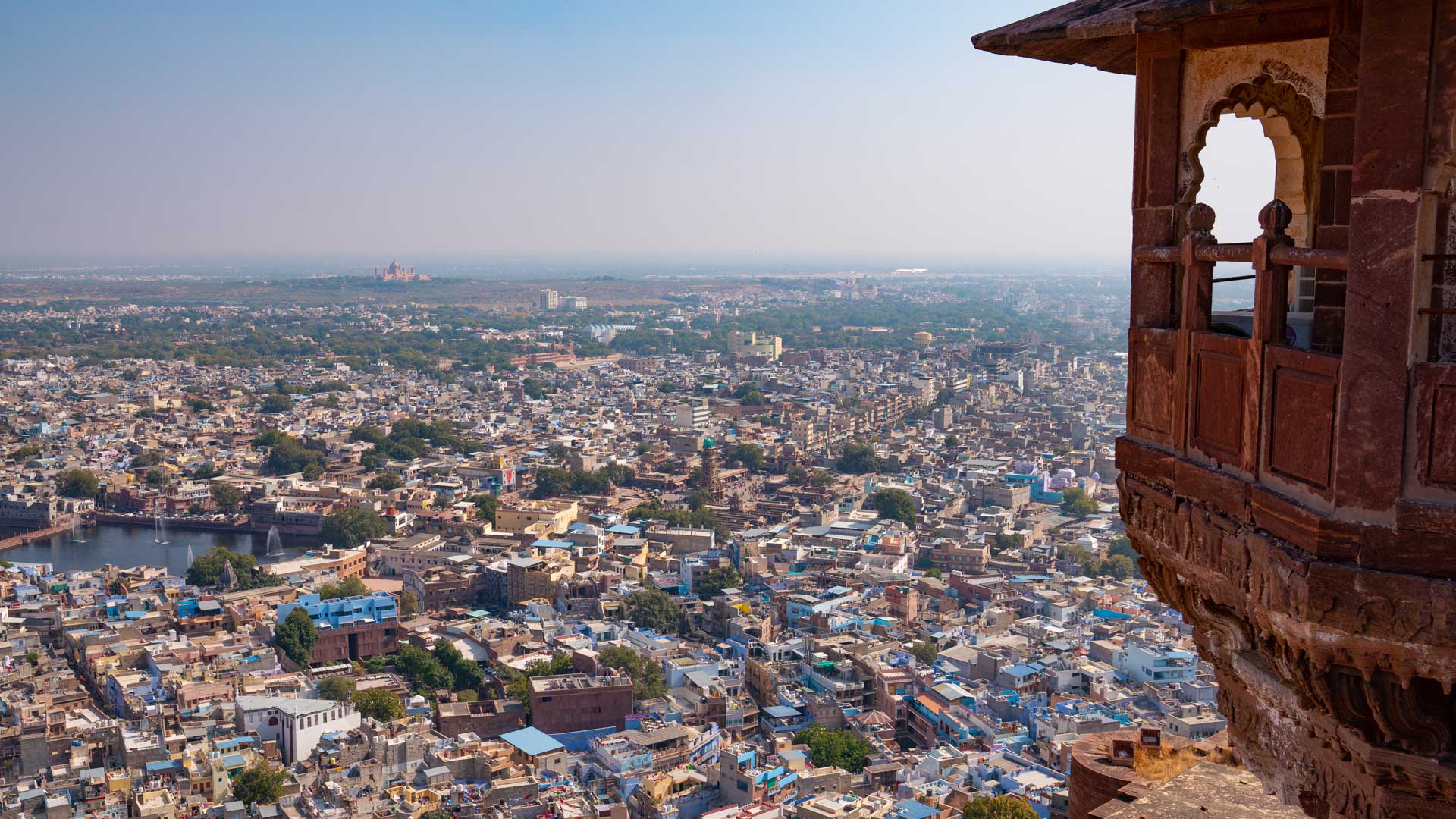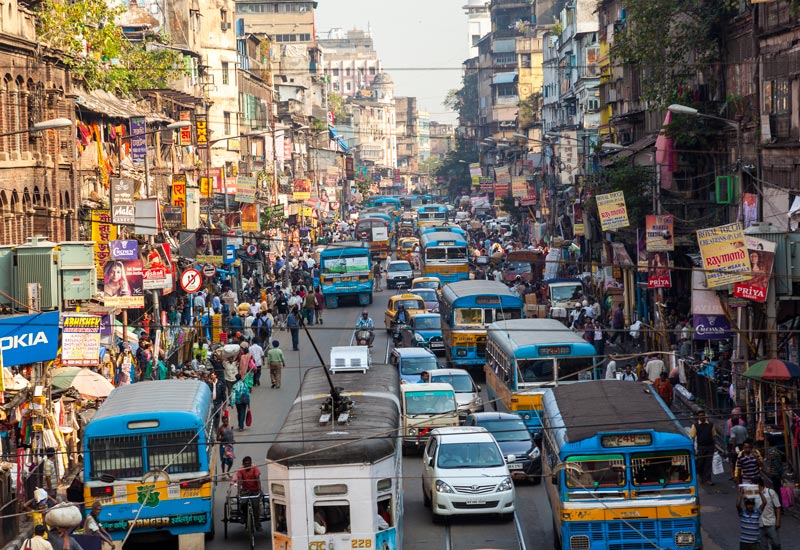Get the right experience for you. Please select your location and investor type.
IMPORTANT NEWS: Transition of investment management responsibilities
First Sentier Group, the global asset management organisation, has announced a strategic transition of Stewart Investors' investment management responsibilities to its affiliate investment team, FSSA Investment Managers, effective Friday, 14 November close of business EST.
One may conclude from the past decade that India is likely to remain a low-growth economy. We disagree. Many ingredients are now in place for a revival in economic growth and sustainable development. Below are some of the macro-economic tailwinds that contribute to this view.
A lower-carbon future
India has only produced 3% of total carbon dioxide emissions historically1. The United States, Europe and China have together contributed 60%1. As a signatory to the Paris Agreement, India has committed to reduce carbon intensity by 33-35% by 20302. As part of this journey, 175 gigawatts (GW) of renewable-generation capacity was already commissioned or in construction by 2022, up from just 34 GW in 20143. Falling solar prices could help India reach its target of 500 GW by 2030 or 60-65% of total generation capacity3. Changes in vehicle emission norms to European standards, rapid evolution of electric vehicle (EV) technology and the introduction of scrappage vehicle policies should further reduce emissions intensity and improve the country’s finances. These are sound reasons to believe India will not follow a similar carbon-intensive development path as the West or even China. Mahindra & Mahindra is the largest maker of EV three wheelers in India, with three wheelers an important part of urban mobility, both for passengers and small freight. The group has started evolving its automotive business to EVs with the commitment of significant capital to this journey.
Early signs of a revival in infrastructure investment & the manufacturing sector
Infrastructure investment has been India’s Achilles heel. It could well be its champion in the next decade. For instance, construction of new roads has continued behind the scenes at a good pace. Private investments and participation have now begun to improve in areas such as airports, gas and power distribution, renewable energy and even parts of the railways. The government has embarked on many difficult but essential reforms in agriculture and labour markets. The pace of reforms is likely to be dictated by acceptance from various stakeholders. This is necessary to ensure the benefits of development are widespread and equitable.
Road construction in India
Source: Ministry of Road Transport and Highways, Indian government.
Funding availability and lower interest rates are necessary ingredients to fuel an investment cycle. The previous cycle was overly dependent on the state banking system as a funding source. Today, insurance companies, infrastructure investment trusts, corporate bond markets and large well-capitalised private banks can participate in financing infrastructure. Unlike what we see elsewhere, corporate and bank balance sheets have been slow to repair in the last decade. The insurance industry’s assets have grown to USD600bn from just USD200bn a decade ago4. If India keeps the long-term inflation genie in the bottle, it could become an attractive destination for long-term debt capital.
India’s manufacturing sector is showing early signs of promise. While the government encourages investment in local manufacturing through attractive taxation and labour reforms, the case is becoming stronger from the bottom-up via productivity improvements. A large domestic market, improving infrastructure and the increasing need to diversify global supply chains add wind to India’s manufacturing sails. Apple’s suppliers have invested close to a billion dollars to set up manufacturing units in recent years5.
Corporate tax rates
Source: Country government statistics and OECD, 2020.
An emerging quality healthcare ecosystem
COVID has put the spotlight firmly back on India’s poor healthcare system. India has only 16 healthcare professionals per 10,000 compared to the 23 prescribed by the WHO6. The problem is made more acute as only 3% of India’s doctors reside in rural areas where much of India’s population resides7. More than 70% of Indians pay for healthcare costs out of their pockets8. A government plan, launched in 2018, to cover 500 million underprivileged people through health insurance is an important step in the right direction9. The program, intermediated by the private insurance sector, is helping improve the quality of affordable healthcare. More than 20,000 hospitals have empaneled themselves to address patients under this scheme10.
Evolution of diagnostic services is an example of how the private sector can deliver quality healthcare intervention at scale. Diagnostics represents a small percentage of total spends but has an outsized impact in reducing healthcare costs through prevention and early detection. The diagnostics industry in India is underpenetrated, and there is a need to formalise the sector and improve quality of service. This means leading, organised players such as Dr. Lal PathLabs are extremely well positioned. In 2021 Dr. Lal PathLabs served 27 mn patients at a cost of USD10 per patient11. Keeping their services affordable means the company addresses a large section of society without compromising on profitability. The presence of family stewards with long-term horizons, and a rock-solid balance sheet, gives them the strength to withstand periods of intense competition.
Diagnostics spend per capita USD
Source: Spark Capital estimates 2022
Early signs of revival of the property cycle
Over the past two years, I have been on record several times stating that I have never been as optimistic about the demand for home loans as I am currently. Despite the recent headwinds in the global macro landscape, I continue to maintain this stance. India is on the cusp of an economic transformation.
Deepak Parekh (Chairman of HDFC – Annual Report 2022)
Structural changes are afoot in how people view homes and the need for work spaces within homes. And property is more affordable today than at any time in the last 25 years12. Tax incentives for affordable housing materially reduce the cost of servicing mortgages. India remains one of the most attractive mortgage markets in the world due to low home ownership, low mortgage penetration, and a young population. Mortgages would have to grow at twice the rate of GDP in the next 10 years just to catch up with China. Aavas Financiers, a provider of mortgages for rural India, operates in a space where mortgage penetration is just 1% of GDP13. Aavas has built a high-quality credit risk culture which is difficult to replicate through capital or technology. Aavas aims to improve home ownership by women in the communities it operates in, with an aspiration to reach 40% of women borrowers in the coming decade14. Aavas is also working with the government to introduce regulations around better and greener building standards for rural areas15. These are the qualities of a leader, and a high-quality company that is addressing many human development challenges through their service.
Improved affordability
Best affordability in 2.5 decades. Government support towards housing has helped improve affordability.
Source: HDFC. Data reflective of HDFC’s customer base.
An emerging quality financial services ecosystem
India has been dealing with a banking crisis unleashed by the excesses of the financial bubble leading up to 2008. The correction process has been helped by the introduction of the IBC (Insolvency and Bankruptcy Code) in 2016, a much needed reform to speed up the resolution of insolvent businesses. The acquisition of CG Power by Tube Investments was evidence of the IBC at work. Many bank failures and multiple rounds of capital raising and corporate deleveraging have occurred in the last decade. As a result, India’s banking system is in a much healthier shape with fewer, but stronger, institutions. Low leverage in the system adds sail to the capex-cycle winds.
Banks in good health: Indian banking sector
(click to view full chart)
Source – Centre for Monitoring Indian Economy (CMIE), Spark Capital estimates for 2022
India’s corporate debt sector at historic lows
(click to view full chart)
Source – International Monetary Fund, 2022
UPI (Unified Payments Interface) is an open payments platform built and owned by the Indian government. A common architecture socialises an important digital railroad. Currently, 376 banks and payment service providers use this railroad to offer easy and low cost payments and transfers for society16. In other markets, this infrastructure is often owned by private entities such as Visa and Mastercard, leading to higher costs for the ecosystem and slower adoption. UPI was conceived by the previous government in 2009 and launched in 2016 by the current government.
Today roughly 376 banks and payment providers are building their services on this platform. As a result, India currently processes 260 million digital transactions per day. This is more than any other country and is well ahead of developed market peers17. We are excited for the technology’s ability to accelerate financial inclusion. A similar social digital infrastructure for retail e-commerce is currently being built by the government.
A noisy democracy
India is a noisy democracy but there is a strong underlying desire for reform and progress. External shocks can introduce obstacles in this development path, but the direction of travel is clear. It is a region which demands patience but rewards patient investors through steady compounding of returns. In our opinion, a large domestic market, evolving macro tailwinds, a clear confluence between sustainable development opportunity and investment returns, an accountable system with checks and balances and a universe of high-quality companies makes India an attractive destination for long-term capital in our opinion.
Stewart Investors’ approach to investing in India
- We are long-term investors.
- We are absolute-return investors. We treat risk as the permanent loss of capital.
- We invest in companies that contribute to, and benefit from, sustainable development.
- We have a proven track record of investing in the Indian subcontinent since 1991.
Investment terms
View our list of investment terms to help you understand the terminology within this website.
Important Information
The information contained within this material is generic in nature and does not contain or constitute investment or investment product advice. The information has been obtained from sources that First Sentier Investors (“FSI”) believes to be reliable and accurate at the time of issue but no representation or warranty, expressed or implied, is made as to the fairness, accuracy, completeness or correctness of the information. To the extent permitted by law, neither FSI, nor any of its associates, nor any director, officer or employee accepts any liability whatsoever for any loss arising directly or indirectly from any use of this material.
This material has been prepared for general information purpose. It does not purport to be comprehensive or to render special advice. The views expressed herein are the views of the writer at the time of issue and not necessarily views of FSI. Such views may change over time. This is not an offer document, and does not constitute an investment recommendation. No person should rely on the content and/or act on the basis of any matter contained in this material without obtaining specific professional advice. The information in this material may not be reproduced in whole or in part or circulated without the prior consent of FSI. This material shall only be used and/or received in accordance with the applicable laws in the relevant jurisdiction.
Reference to specific securities (if any) is included for the purpose of illustration only and should not be construed as a recommendation to buy or sell the same. All securities mentioned herein may or may not form part of the holdings of First Sentier Investors’ portfolios at a certain point in time, and the holdings may change over time.
In Hong Kong, this material is issued by First Sentier Investors (Hong Kong) Limited and has not been reviewed by the Securities & Futures Commission in Hong Kong. In Singapore, this material is issued by First Sentier Investors (Singapore) whose company registration number is 196900420D. This advertisement or material has not been reviewed by the Monetary Authority of Singapore. First Sentier Investors, FSSA Investment Managers, Stewart Investors, RQI Investors and Igneo Infrastructure Partners are the business names of First Sentier Investors (Hong Kong) Limited. First Sentier Investors (registration number 53236800B), FSSA Investment Managers (registration number 53314080C), Stewart Investors (registration number 53310114W), RQI Investors (registration number 53472532E) and Igneo Infrastructure Partners (registration number 53447928J) are the business divisions of First Sentier Investors (Singapore).
First Sentier Investors (Hong Kong) Limited and First Sentier Investors (Singapore) are part of the investment management business of First Sentier Investors, which is ultimately owned by Mitsubishi UFJ Financial Group, Inc. (“MUFG”), a global financial group. First Sentier Investors includes a number of entities in different jurisdictions.
MUFG and its subsidiaries are not responsible for any statement or information contained in this material. Neither MUFG nor any of its subsidiaries guarantee the performance of any investment or entity referred to in this material or the repayment of capital. Any investments referred to are not deposits or other liabilities of MUFG or its subsidiaries, and are subject to investment risk, including loss of income and capital invested.



